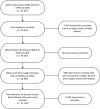Time trends in perinatal outcomes among HIV-positive pregnant women in Northern Tanzania: A registry-based study
- PMID: 37561712
- PMCID: PMC10414606
- DOI: 10.1371/journal.pone.0289740
Time trends in perinatal outcomes among HIV-positive pregnant women in Northern Tanzania: A registry-based study
Abstract
Introduction: Maternal HIV infection is associated with increased risk of having a preterm delivery, low birth weight baby, small for gestational age baby and stillbirth. Maternal use of combination antiretroviral treatment is also associated with preterm delivery and low birth weight, although the effects vary by the type of drugs and timing of initiation.
Objective: To examine time trends in adverse perinatal outcomes among HIV-positive compared with HIV-negative women.
Design: Registry-based cohort study.
Setting: Northern Tanzania, 2000-2018.
Study sample: Mother-baby pairs of singleton deliveries (n = 41 156).
Methods: Perinatal outcomes of HIV-positive women were compared with HIV-negative women during time periods representing shifts in prevention of mother-to-child transmission guidelines. Monotherapy was used as first-line therapy before 2007 while combination antiretroviral treatment was routinely used from 2007. Log binomial and quantile regression were used to analyze the data.
Main outcome measures: Preterm delivery, low birth weight, perinatal death, stillbirth, low Apgar score, transfer to neonatal care unit and small for gestational age.
Results: Overall, maternal HIV infection was associated with a higher risk of low birth weight and small for gestational age. Moreover, this pattern became more pronounced over time for low birth weight, the last time period being an exception. For other outcomes we found none or only a small overall association with maternal HIV infection, although a trend towards higher risk over time in HIV-positive compared with HIV-negative women was observed for preterm delivery and perinatal death. Quantile regression showed an increase in birth weight in babies born to HIV-negative women over time and a corresponding decline in birth weight in babies born to HIV-positive women.
Conclusion: Unfavourable trends in some of the selected perinatal outcomes were seen for HIV-positive compared with HIV-negative women. Potential side-effects of combination antiretroviral treatment in pregnancy should be further explored.
Copyright: © 2023 Rebnord et al. This is an open access article distributed under the terms of the Creative Commons Attribution License, which permits unrestricted use, distribution, and reproduction in any medium, provided the original author and source are credited.
Conflict of interest statement
The authors have declared that no competing interests exist.
Figures



References
-
- UNAIDS. AIDSinfo 2021 [cited 2022 17 March]. https://www.unaids.org/sites/default/files/media_asset/UNAIDS_FactSheet_....
-
- HIV estimates with uncertainty bounds 1990-present [Internet]. UNAIDS. 2021 [cited 17 March 2022]. http://www.unaids.org/sites/default/files/media_asset/HIV_estimates_from....
-
- Organization WH. Mother-to-child transmission of HIV 2022 [cited 2022 17 March]. https://www.who.int/teams/global-hiv-hepatitis-and-stis-programmes/hiv/p....
MeSH terms
LinkOut - more resources
Full Text Sources
Medical

